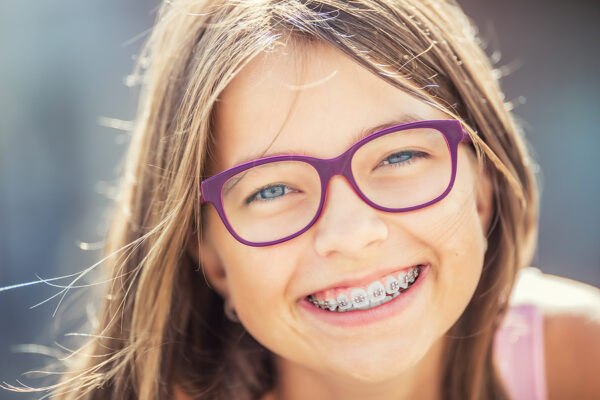When it comes to straightening your teeth, there are more options than ever before. Two of the most popular treatments today are traditional braces and Invisalign clear aligners. At Dahar Orthodontics, we understand that choosing the right treatment can feel overwhelming, which is why we’re here to break down the differences between braces and Invisalign to help you make the best decision for your smile.
Braces: A Time-Tested Solution
Traditional braces have been the go-to treatment for decades. Braces consist of metal brackets attached to the teeth, connected by wires and elastic bands. The system applies steady pressure on your teeth to gradually move them into the desired position.
Advantages of Braces:
- Effective for Complex Cases: Braces are often the preferred choice for individuals with more severe orthodontic issues, such as large gaps, severe crowding, or complex bite problems.
- No Compliance Required: Once the braces are on, you don’t have to worry about remembering to wear them, as they are permanently fixed to your teeth throughout the treatment.
- Durability: Traditional braces are sturdy and effective, especially for teenagers who may be less diligent about wearing aligners as instructed.
However, there are some downsides to braces:
- Aesthetic Concerns: Braces are more visible than Invisalign, which can make some people feel self-conscious about their appearance.
- Comfort: The brackets and wires can sometimes cause irritation to the inside of your mouth, especially after adjustments.
- Food Restrictions: Sticky, hard, or chewy foods must be avoided to prevent damage to brackets and wires.
Invisalign: Discreet and Convenient
Invisalign offers a more discreet and flexible alternative to traditional braces. Invisalign uses clear, custom-made aligners that fit over your teeth and gently shift them into place. The aligners are removable, which means you can take them out to eat, brush, and floss.
Advantages of Invisalign:
- Clear and Discreet: Since the aligners are virtually invisible, they’re a great option for adults and teens who want to straighten their teeth without drawing attention.
- Comfort: Invisalign aligners are smooth and custom-fitted, reducing the likelihood of discomfort or mouth irritation.
- Removable: You can take your aligners out for meals, brushing and flossing, which makes maintaining oral hygiene easier than with traditional braces.
However, Invisalign may not be suitable for everyone:
- Compliance Required: To achieve the best results, you need to wear your aligners for at least 22 hours a day. If you’re not disciplined about wearing them, treatment could take longer.
- Not Ideal for Severe Cases: While Invisalign can handle many orthodontic issues, it may not be as effective for complex cases as traditional braces.
Lifestyle Considerations
When deciding between braces and Invisalign, consider your daily routine, age, and treatment goals.
-
Teens and Children: Braces might be a better choice due to their durability and the lack of reliance on patient compliance.
-
Adults and Working Professionals: Invisalign often appeals more due to its discreet appearance and removable nature.
-
Athletes and Musicians: Invisalign may be more comfortable for those playing wind instruments or participating in contact sports.
Which One is Right for You?
Choosing between Braces vs. Invisalign ultimately depends on your specific needs, lifestyle, and preferences. If you have a more complex dental issue or prefer a permanent solution, traditional braces might be the best choice. On the other hand, if you value discretion, comfort, and the ability to remove your aligners, Invisalign could be the better option.
At Dahar Orthodontics, we work closely with each patient to assess their unique situation and recommend the treatment that will provide the best results. Whether you choose braces or Invisalign, our goal is to help you achieve a beautiful, healthy smile.
Both options have proven effective in delivering long-term results when followed correctly. Our experienced orthodontic team will guide you through every step of the process. Ready to explore your Braces vs. Invisalign options? Book your consultation today and take the first step toward your ideal smile.
FAQs About Braces vs. Invisalign
Q: How long does treatment typically take?
A: Treatment with braces or Invisalign usually takes 12–24 months, depending on the complexity of your case. Some mild cases with Invisalign can be completed in as little as 6 months.
Q: Which option is more affordable?
A: Braces are generally more affordable upfront, but Invisalign’s cost can be comparable depending on your treatment plan and insurance coverage.
Q: Are there any foods I can’t eat with Invisalign?
A: No! Since Invisalign aligners are removable, you can eat whatever you like. Just remember to brush your teeth before putting the aligners back in.
Q: Will people know I’m wearing Invisalign?
A: Most people won’t notice you’re wearing Invisalign aligners because they are clear and fit snugly over your teeth.
Q: Can kids use Invisalign?
A: Yes, Invisalign offers a product specifically for younger patients called Invisalign Teen, which includes features like compliance indicators and replacement aligners.
Q: Can I switch from braces to Invisalign mid-treatment?
A: In some cases, yes. If your orthodontist determines it’s appropriate, you may be able to switch to Invisalign after starting with braces. A consultation is necessary to evaluate if this is a suitable option for your specific case.
Contact Dahar Orthodontics Today
Ready to start your journey to a better smile? Schedule a consultation with Dahar Orthodontics, and let us help you decide which orthodontic treatment is right for you. Our team is dedicated to providing personalized care and delivering the highest-quality results, no matter which option you choose.
Whether you’re leaning toward braces or Invisalign, we’ll walk you through every detail from treatment timelines and costs to maintenance and aftercare. Our goal is to make your orthodontic experience smooth, comfortable, and successful.
We use the latest technology and treatment techniques to ensure you receive the most accurate diagnosis and customized care plan. At Dahar Orthodontics, your smile is our top priority—and we’re here to support you every step of the way.
Call us today or book an appointment online to get started. A confident, healthy smile is just a consultation away!


